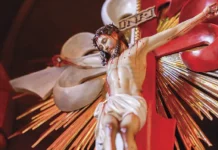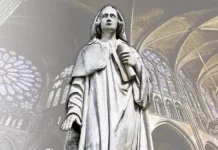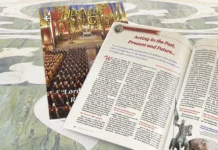The glorious cradle of Teresa of Avila’s vocation remained oblivious to this Saint’s reform for four hundred years. The skilful intervention of one of her daughters obtained the long-awaited restoration, and was crowned by an exciting discovery.
Avila, 1562. After twenty-seven years of cloistered life in the Monastery of the Incarnation, Teresa of Jesus left the almost one hundred and eighty religious who had accompanied her in her first steps in her vocation, and set out on the greatest adventure of her life: the reform of the Carmelite Order.
Taking only what was indispensable for her first foundation, she said goodbye to those walls, the silent witnesses of her blessed journey: the door through which she entered the monastery, the parlour where Our Lord had rebuked her for engaging in worldly conversations, the cell in which she had dwelt and had so often held supernatural colloquy with Him, the stairway where once she had met a beautiful Child who declared to her that He was “Jesus of Teresa”…

Yet, despite having been the starting point of the Carmelite renewal, this glorious monastery would welcome her only four hundred years later, through the skilled and virtuous intervention of one of her spiritual daughters in the twentieth century.
Indeed, many years after her departure, and having won countless victories for Our Lady of Mount Carmel, St. Teresa was led by obedience back to her community, this time as superior. She met, however, with stiff opposition from the nuns there, who, in an act of manifest rebellion, denied her entrance and possession of office… The outcome of the bitter hardship she endured there was that, at her death, the Monastery of the Incarnation remained as “calced” as before; that is to say, it had not adhered to the discalced renewal she desired.
First stirrings of transformation
In 1940, certainly through the heavenly intercession of the foundress, this monastery did accept the reform, although it still needed to make progress on many points. The four centuries of resistance had deeply marked the community, and there were difficulties in fully adhering to the Teresian spirit.
Since the spiritual state of a group of people is often reflected in the material reality which surrounds it, in 1966 – twenty-six years later! – the lack of fervour of those Carmelite nuns and their desire for leniency in observing the rule were lamentably reflected in the physical condition of the monastery which, battered by time, was on the point of collapse. The convent, which had housed more than a hundred nuns in the time of St. Teresa, was reduced to a small community consisting mostly of elderly sisters, who were unable to manage the maintenance of the building.
In addition, as this monastery was the cradle of the Teresian vocation, a great number of pilgrims, wishing to imbibe the spirit of the Saint, now visited it every year, creating no small disruption in the contemplative life that ought to be led there.
Another “Teresa” to reform the Incarnation

Although the Sisters of the Incarnation were aware of the deplorable situation of the monastery, they felt unable to take on the mission of reforming it, both because of the economic resources and the moral strength that would be required to carry this out. It was necessary to find someone capable of moving generous souls to finance the work and, above all, someone with a selfless heart who was ready to suffer the adversities that such a vast project would involve.
The community’s confessor, Fr. Crisógono de Jesus Sacramentado, and the Bishop of Avila, Most Rev. Santos Moro Briz, seeking a solution to the problem, came to the conclusion that the only person capable of accomplishing this work was Mother Maravillas de Jesus, prioress of the monastery of Aldehuela, near Madrid, who had recently completed the restoration of the Carmelite community of El Escorial.
Accordingly, they asked her, in the name of the religious of the Incarnation and of the diocese, to take charge of the restoration, not only of the buildings, but also of the souls, bringing with her other nuns of her foundations who could help her. Nevertheless, Mother Maravillas considered herself unqualified for such a mission… Determined to convince her, Bishop Santos wrote to her in January 1966, affirming that if she did not accept the task, God would call her to account for the ruin of such a venerable monastery.
It thus became clear to Mother Maravillas that her intervention was indeed necessary to prevent the complete destruction of the community of the Incarnation. Out of love for her spiritual mother, St. Teresa, she prepared to take on the difficult task, despite her seventy-four years of age and fragile health.
The fight to open souls
Before communicating her decision to the General of the Order, Mother Maravillas visited the monastery twice and saw the sorry state into which it had fallen. According to the reports of the religious who accompanied her, the nuns there “were quite alarmed” and “did not want [Mother Maravillas] to come with plans to correct and reform the community spiritually. They only wanted financial assistance and nuns to help them materially.”1
To move wills and to open hearts is much more difficult than to construct buildings and raise walls… Nevertheless, little by little, Mother Maravillas convinced the nuns to accept the conditions for the reform and in the end they all came to love her, which caused no little amazement in those who were acquainted with the previous dispositions of the community.
It is known that this soul chosen and loved by the Blessed Virgin asked the Lord to enlighten her before choosing the Carmelites who were to accompany her in her arduous mission, letting it be seen in some letters how much she wished them to be the most observant and virtuous. After a meticulous selection, Mother Maravillas nominated Mother Magdalene of Jesus as the new prioress and, besides the eight nuns designated to assist her, she entrusted the repairs of the building to Sr. Isabel de Jesus, who, while not being an architect, planned all her foundations.
The first steps towards the reform of the Incarnation had finally been taken.
Unwavering determination in obtaining resources
Having achieved the opening of souls and established a group of auxiliary Carmelite nuns, the first practical concern of Mother Maravillas was to turn her attention to the extremely urgent material needs of the community.
According to expert opinion, the monastery was being held up by a real miracle, which the sisters attributed to St. Teresa. Between forty and fifty support posts needed urgently to be placed to prevent the building’s downfall! The roofs tiles had to be torn up, the attics rebuilt, the wooden beams, almost rotten and splintered, had to be replaced by others of cement and iron, new cells had to be built, the church restored, and many other repairs made…
With unwavering determination, Mother Maravillas decided to begin the renovation by asking government officials for financial help, convinced that the conservation of such a valuable relic was also their responsibility. It was then that a veritable battalion of architects, stonemasons and labourers of all kinds began work on the convent.
Inspired by the historical value of the building and the symbolism of its every corner, the workers were tireless in their efforts, which would soon be well rewarded by Heaven through an unexpected and surprising gift.
A present from St. Teresa

During the painstaking restoration, the door through which St. Teresa had entered the monastery on her appointment as prioress in 1571 was found, as well as various windows and paintings from that period. However, the greatest and most interesting discovery was made on December 3, 1968.
On the instructions of Sr. Isabel, workers had for several days been endeavouring to knock down one of the walls in the Chapel of the Transverberation, built years before on the site of St. Teresa’s cell. The Carmelite “architect” hoped that behind one of those walls could be found part of the foundress’ cell or kitchen, because, from the measurements of the building, it was calculated that there was a space between the wall of the chapel and what would have then been the door of the cell.
After days of toil, the workmen made the surprising discovery of the coveted kitchen in which St. Teresa had prepared her meals for twenty-seven years! The blackened bricks still perfectly formed the arch of the chimney, and the odour of smoke concentrated by centuries of enclosure was perceptible just by drawing near.
Astonishment and emotion filled the hearts of all those present, when they saw their efforts generously rewarded with the finding of such a unique relic.
Summoned to verify what had happened, the former prioress of the monastery, Mother Incarnation, after staring for some time at the ceiling and the whole kitchen, remained motionless for several minutes. Her marked pallor attracted the attention of everyone there and, as she did not stir, some thought she had taken ill. Without, however, answering the questions put to her, Mother Incarnation kept her eyes fixed on that small but blessed space. After some time, she explained what had happened. She had seen St. Teresa herself there, who had told her: “Rest assured, for everything that the Mothers are doing in this holy house is pleasing to me and very well done.”2

The holiness of the reform undertaken by Mother Maravillas and her sisters was thus sealed with a supernatural communication, and it was proved once again how much God blesses, even in this life, those who care for His works: “whatever good any one does, he will receive the same again from the Lord” (Eph 6:8).
The Carmelite spirit is restored
The renovation of the building was completed in a record time of five years. To facilitate the observance of the rule, the punctuality of schedules and the participation of the community in common acts, the design of the cells was modified, making them smaller, more cheerful and sunny. A new choir was erected for the use of the nuns, and the old one, with the place where St. Teresa had knelt to receive Communion, was exposed for public visitation. A Teresian museum was also planned with all the mementos of the Saint so that they could be venerated by pilgrims.
In addition, due to the influx of the faithful and priests who wished to celebrate Mass in the monastery, Mother Maravillas entrusted the service of the external sacristy and the care of pilgrims to a newly founded congregation, the Servants of the Gospel, and constructed a building annexed to the monastery to house these religious women.

On the other hand, no less glorious than the material restoration was the moral transformation brought about by the wisdom of Mother Maravillas. Through patience and good example, discipline and the Teresian spirit gradually took root in the Monastery of the Incarnation. The community began to observe the holy customs of the discalced reform, and peace and unity were soon established among the sisters.
Let us collaborate in the reform of the world!
Scripture says that “where sin increased, grace abounded all the more” (Rom 5:20). Although resistance to divine grace held sway for four hundred years in that monastery which was the cradle of the vocation of St. Teresa of Jesus, there, too, the mercy of God triumphed magnificently and, through the virtuous action of a chosen soul, marked the history of the Carmelite Order for ever.
In our present days, as we witness the undeniable increase of sin, let us ask St. Teresa, Mother Maravillas of Jesus and all the Carmelite Saints to watch over our souls and make them docile to the action of the Divine Holy Spirit and of the men chosen by Him, so that we may collaborate in the reform of the world and triumph with them in the Reign of Mary! ◊
Notes
1 GONZÁLEZ CHAVES, Alberto José. A casa de Teresa. 50 años de la restauración del Monasterio de la Encarnación de Ávila por Santa Maravillas de Jesús [The House of Teresa. 50 Years of Restoration at the Monastery of the Incarnation of Avila by St. Maravillas of Jesus]. In: Santa Madre Maravillas de Jesús. Madrid. N.178 (2016); p.6.
2 MAGDALENA DE JESÚS, OCD. Un hallazgo singular [A Rare Discovery]. In: Santa Madre Maravillas de Jesús. Madrid. N.178 (2016); p.19.







